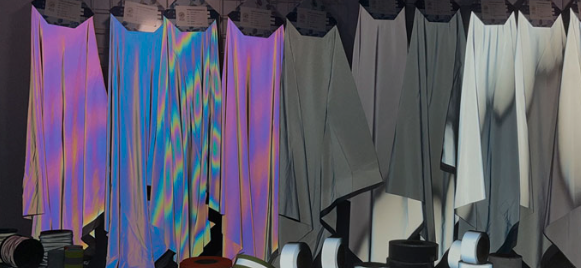Revolutionizing The Fabric Of Technology: A Deep Dive into Smart Textiles

Smart textiles, a remarkable intersection of technology and fashion, are transforming the way we interact with our clothing and the world around us. These textiles, also known as e-textiles or electronic textiles, are imbued with advanced materials and technologies that enable them to sense, react, and adapt to various environmental stimuli. This article delves into the fascinating realm of smart textiles, exploring their composition, applications, and the potential they hold for the future.
I. Understanding Smart Textiles
A. Definition and Composition: Smart textiles refer to fabrics that integrate electronic components and functionalities, ranging from sensors and actuators to conductive fibers and embedded microelectronics. These components are seamlessly woven or integrated into the fabric, making them inconspicuous and comfortable for wearers.
B. Types of Smart Textiles:
- Passive Smart Textiles: These fabrics respond to external stimuli without the need for an external power source. An example is thermochromic fabric that changes color based on temperature.
- Active Smart Textiles: These textiles incorporate components like sensors and actuators that require an external power source. A notable example is a smart shirt with embedded sensors that monitor physiological parameters.
- Ultra-Smart Textiles: Combining both passive and active elements, ultra-smart textiles possess a high level of interactivity and adaptability. They can respond to various inputs and adjust their properties accordingly.
II. Applications of Smart Textiles
A. Healthcare and Wearable Technology:
- Smart Fabrics for Monitoring: Clothing with integrated sensors can monitor vital signs, providing valuable data for healthcare professionals. This has implications for remote patient monitoring and early detection of health issues.
- Rehabilitation and Assistance: Smart textiles can assist individuals with disabilities by incorporating sensors and actuators into garments. For instance, a shirt with haptic feedback could aid individuals with visual impairments in navigating their surroundings.
B. Fashion and Aesthetics:
- Interactive Fashion Shows: Designers are incorporating smart textiles into their creations, leading to interactive fashion shows where garments respond to music, movement, or even the audience’s emotions.
- Adaptive Clothing: Smart textiles can be used to create adaptive clothing that adjusts to temperature changes or wearer preferences. This could revolutionize the fashion industry, offering both style and comfort.
C. Sports and Performance:
- Biometric Monitoring in Sportswear: Athletes can benefit from smart textiles that monitor biometric data, such as heart rate and body temperature. This information helps optimize performance and prevent injuries.
- Impact-Resistant Gear: Protective gear for athletes and extreme sports enthusiasts can be enhanced with smart textiles that stiffen upon impact, providing an additional layer of safety.
III. Technological Innovations in Smart Textiles
A. Conductive Fibers and Materials:
- Graphene-Based Textiles: The integration of graphene into fabrics enhances conductivity, flexibility, and durability. Graphene-based smart textiles can be used in a variety of applications, from energy storage to sensing.
- Conductive Yarns: The development of yarns with conductive properties allows for the creation of fabrics that can transmit electrical signals. This opens up possibilities for advanced sensor networks in clothing.
B. Nanotechnology in Textiles:
- Nanofibers for Enhanced Properties: The use of nanofibers in smart textiles provides benefits such as increased surface area, improved strength, and enhanced sensing capabilities.
- Self-Cleaning Textiles: Nanotechnology enables the creation of textiles with self-cleaning properties, repelling stains and eliminating the need for frequent washing.
C. Energy-Harvesting Textiles:
- Solar Textiles: Fabrics integrated with photovoltaic cells can convert sunlight into electricity, powering electronic components within the textile. This innovation has implications for portable device charging and energy-efficient clothing.
- Triboelectric Generators: Textiles that harness the energy generated by friction between different materials, such as clothing and the wearer’s skin, offer a sustainable way to power electronic devices.
IV. Challenges and Future Outlook
A. Challenges in Integration:
- Flexibility and Durability: Ensuring that smart textiles maintain flexibility and durability after multiple washes and wear is a key challenge for researchers and manufacturers.
- Power Supply: Developing efficient and lightweight power sources for active smart textiles remains a hurdle, especially for applications that require prolonged usage.
B. Environmental Concerns:
- End-of-Life Disposal: The integration of electronic components in textiles raises concerns about the disposal of these garments at the end of their life cycle and the environmental impact of e-waste.
C. Future Possibilities:
- Health Monitoring Advancements: Smart textiles could play a pivotal role in preventive healthcare, with continuous monitoring of health parameters and early detection of diseases.
- Integration with Augmented Reality: The integration of smart textiles with augmented reality could create immersive experiences, where clothing becomes a part of interactive digital environments.
V. Conclusion: The Fabric of Tomorrow
Smart textiles represent a convergence of technology, design, and functionality, offering a myriad of possibilities across various industries. As researchers continue to push the boundaries of innovation, smart textiles are poised to revolutionize not only our wardrobes but also our daily lives. The seamless integration of electronics into fabrics is unlocking a new era of interactive and adaptive clothing, paving the way for a future where our garments are as intelligent as the devices we carry. As we embark on this journey, the evolution of smart textiles promises to weave a tapestry of ingenuity and practicality, shaping the fabric of tomorrow in ways we are only beginning to fathom.




